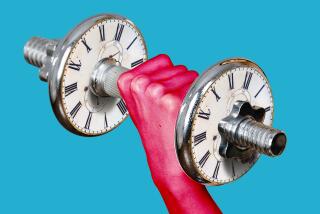Exercise Looks to Be the Best Way to Halt Middle-Age Spread
- Share via
For most people, widening waistlines are an all-too-obvious fact of midlife.
“The average American experiences a 10- to 15-pound weight gain during middle age,” says Loretta DiPietro, associate professor of epidemiology and public health at the Yale University School of Medicine. Commonly known as “middle-age spread,” this girth gain typically occurs between ages 40 and 60 and contributes to the alarming incidence of obesity-related health problems in our culture.
While most people try to battle the bulge by dieting, DiPietro notes that “the long-term success rate of this method is quite poor.” In contrast, “regular exercise may be associated with better long-term weight control than dieting alone,” she writes in a new statement on “Exercise and Age-Related Weight Gain,” released late last year by the American College of Sports Medicine.
*
The reasons for midlife weight gain are not fully understood by health experts. It may be a vestige of human evolution, DiPietro says, a protective counterbalance to the weight loss that is a common health problem among the elderly.
But in a society in which one-third of adults are obese, plumping up even more during midlife hardly seems helpful.
Many experts contend that much of today’s “middle age spread” actually occurs because most people’s activity levels decline dramatically with age, while their food consumption stays the same or even increases.
Also, sedentary people begin to lose muscle in midlife, with a “pretty clear drop-off in muscle mass around age 55,” says Robert Mazzeo, a professor of exercise physiology at the University of Colorado at Boulder. Since muscle is one of the body’s most metabolically active tissues--acting like an “engine” to burn fuel--muscle loss has wide-ranging physiological effects that can include obesity, impaired glucose tolerance, declines in cardiovascular function, bone weakening and changes in the body’s ability to regulate temperature.
“Every pound of muscle we lose lowers our metabolic rate by between 35 and 50 calories per day, and every pound of muscle we gain raises our metabolic rate by between 35 and 50 calories per day,” says exercise physiologist Wayne Westcott, fitness research director at the South Shore YMCA in Quincy, Mass., and author of 13 books on strength training.
“Research shows that basal metabolism slows down at the rate of 3% to 5% per decade for adults. This may be more closely related to our muscular conditioning than to our chronological age.”
The best way to prevent substantial weight gain with age, experts say, is with regular exercise. The college of sports medicine advises adults to participate in a well-rounded program that includes some form of aerobic exercise for 20 to 60 minutes three to five days a week; resistance exercises (such as lifting weights or using a strength-training machine) two or three days a week; and stretching exercises at least two days a week.
Even getting 30 minutes of moderate exercise on most days of the week is enough to significantly minimize age-related weight gain, says Yale’s DiPietro. She notes that this amount of exercise may not be enough to lose much--if any--weight. Activity of longer duration or higher intensity would probably be needed to shed a substantial number of pounds.
She says increasing evidence suggests “that regular physical activity may be useful in minimizing age-related weight gain or reducing the risk of substantial weight gain, rather than in actually promoting weight loss.”
DiPietro’s recent study of more than 5,000 middle-aged men and women examined how exercise influences weight control by comparing improvements in cardiorespiratory fitness (measured by performance on a treadmill) with changes in body weight over a seven-year period. Improvements in treadmill time are generally a consequence of increased physical activity, DiPietro says. The study found that for every one-minute improvement in treadmill time, people lost 1.3 pounds compared with people who didn’t improve their treadmill time.
The study, which was published last year in the International Journal of Obesity, also concluded that “more substantial improvements of three and five minutes were related to actual weight loss. Further, each one-minute improvement in treadmill time reduced the chance of an 11-pound weight gain by 14% in men and by 9% in women, and the chance of a 22-pound gain by 21% in both men and women.”
These reductions in weight gain may seem small, DiPietro acknowledges, “but when you multiply them over the decades of middle age, they accumulate into a net savings that is quite meaningful. It’s like putting a penny into a bank every day. It’s just a penny, but over 10 years it adds up.”
*
Simply maintaining a given level of fitness doesn’t appear to be enough to ward off a slow increase in body weight through middle age. DiPietro’s study and others suggest that increasing amounts of physical activity may be necessary to effectively maintain a constant body weight with increasing age.
“Research has shown that even people who run daily may add some weight in midlife,” she says. While physical activity favorably affects body composition--by burning fat and preserving lean mass--other factors also play roles in body weight, she notes, including heredity, hormones and food consumption.
“The question to ask is, how important is it to maintain a constant body weight with increased age if you’re healthy?” DiPietro says. “As a culture we’re obsessed with not gaining weight. But if you’re a normal weight and otherwise healthy, is a five- or even 10-pound weight gain in midlife really all that bad?”
For people who are already overweight, however, these excess pounds can significantly increase the risk of metabolic disorders commonly found in later years, such as diabetes and high cholesterol, DiPietro notes. As with most health problems, the best cure is prevention.
“The public health challenge,” she says, “lies in promoting an active lifestyle early in life, which can be maintained throughout adulthood, to prevent substantial weight gain and obesity with age.”






